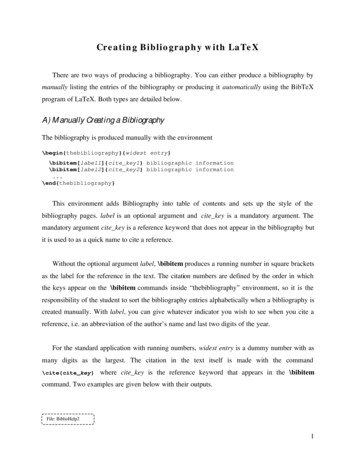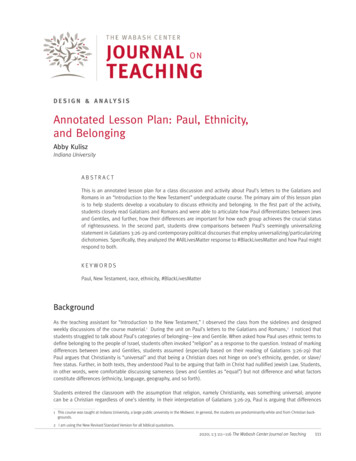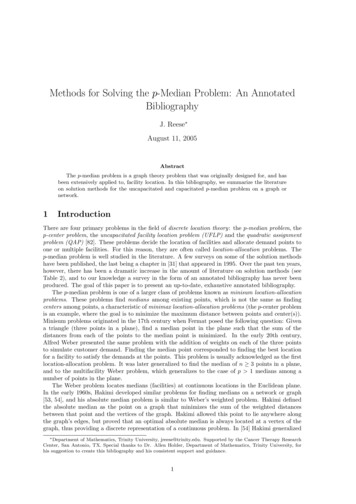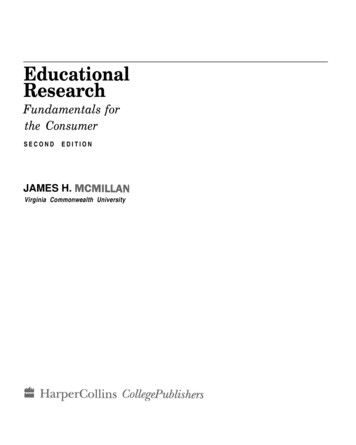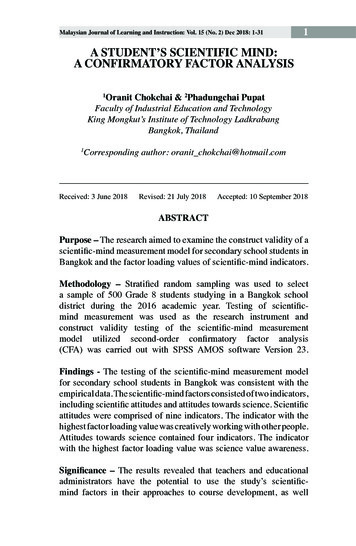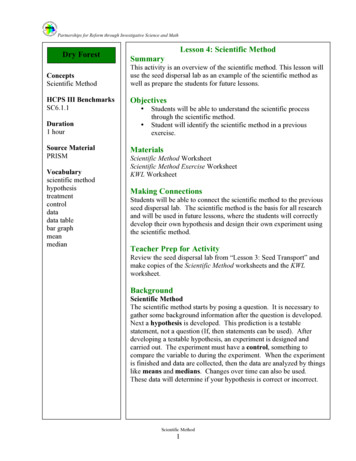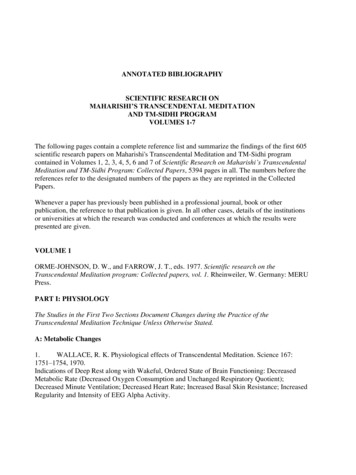
Transcription
ANNOTATED BIBLIOGRAPHYSCIENTIFIC RESEARCH ONMAHARISHI’S TRANSCENDENTAL MEDITATIONAND TM-SIDHI PROGRAMVOLUMES 1-7The following pages contain a complete reference list and summarize the findings of the first 605scientific research papers on Maharishi's Transcendental Meditation and TM-Sidhi programcontained in Volumes 1, 2, 3, 4, 5, 6 and 7 of Scientific Research on Maharishi’s TranscendentalMeditation and TM-Sidhi Program: Collected Papers, 5394 pages in all. The numbers before thereferences refer to the designated numbers of the papers as they are reprinted in the CollectedPapers.Whenever a paper has previously been published in a professional journal, book or otherpublication, the reference to that publication is given. In all other cases, details of the institutionsor universities at which the research was conducted and conferences at which the results werepresented are given.VOLUME 1ORME-JOHNSON, D. W., and FARROW, J. T., eds. 1977. Scientific research on theTranscendental Meditation program: Collected papers, vol. 1. Rheinweiler, W. Germany: MERUPress.PART I: PHYSIOLOGYThe Studies in the First Two Sections Document Changes during the Practice of theTranscendental Meditation Technique Unless Otherwise Stated.A: Metabolic Changes1.WALLACE, R. K. Physiological effects of Transcendental Meditation. Science 167:1751–1754, 1970.Indications of Deep Rest along with Wakeful, Ordered State of Brain Functioning: DecreasedMetabolic Rate (Decreased Oxygen Consumption and Unchanged Respiratory Quotient);Decreased Minute Ventilation; Decreased Heart Rate; Increased Basal Skin Resistance; IncreasedRegularity and Intensity of EEG Alpha Activity.
2.WALLACE, R. K. The physiological effects of Transcendental Meditation: A proposedfourth major state of consciousness. Doctoral thesis, Department of Physiology, School ofMedicine, University of California at Los Angeles, Los Angeles, California, U.S.A., 1970.Indications of Deep Rest along with Wakeful, Ordered State of Brain Functioning: DecreasedMetabolic Rate (Decreased Oxygen Consumption and Decreased Carbon Dioxide Elimination);Normal Arterial Oxygen and Carbon Dioxide Partial Pressures; Decreased Respiration Rate;Decreased Heart Rate; Increased Basal Skin Resistance; Increased Regularity and Intensity ofEEG Alpha Activity in Frontal and Central Regions. Reduction in Biochemical Index of Stress:Decreased Arterial Lactate Levels. Self-Reported Improvements in Physical and Mental Health,and Resistance to Disease.3.WALLACE, R. K., et al. A wakeful hypometabolic physiologic state. American Journalof Physiology 221: 795–799, 1971.Indications of Deep Rest along with Wakeful, Ordered State of Brain Functioning: DecreasedMetabolic Rate (Decreased Oxygen Consumption and Decreased Carbon Dioxide Elimination);Normal Arterial Oxygen and Carbon Dioxide Partial Pressures; Decreased Respiration Rate;Decreased Minute Ventilation; Decreased Heart Rate; Increased Basal Skin Resistance; IncreasedRegularity and Intensity of EEG Alpha Activity in Frontal and Central Regions; Episodes ofRhythmical EEG Theta Activity in Frontal Region. Reduction in Biochemical Index of Stress:Decreased Arterial Lactate Levels.4.WALLACE, R. K., et al. The physiology of meditation. Scientific American 226: 84–90,1972.Indications of Deep Rest along with Wakeful, Ordered State of Brain Functioning: DecreasedMetabolic Rate (Decreased Oxygen Consumption and Decreased Carbon Dioxide Elimination);Normal Arterial Oxygen and Carbon Dioxide Partial Pressures; Decreased Respiration Rate;Decreased Minute Ventilation; Decreased Heart Rate; Increased Skin Resistance; IncreasedRegularity and Intensity of EEG Alpha Activity in Frontal and Central Regions. Reduction inBiochemical Index of Stress: Decreased Arterial Lactate Levels.5.ALLISON, J. Respiratory changes during Transcendental Meditation. Lancet (7651): 833,1970.Indication of Deep Rest: Decreased Respiration Rate.6.COREY, P. W. Airway conductance and oxygen consumption changes associated withpractice of the Transcendental Meditation technique. University of Colorado Medical Center,Denver, Colorado, U.S.A., 1973.Increased Ease of Breathing: Increased Airway Conductance. Indications of Deep Rest: DecreasedMetabolic Rate (Decreased Oxygen Consumption and Decreased Carbon Dioxide Elimination);Decreased Heart Rate. Maintenance of a Relaxed Style of Physiological Functioning Outside ofMeditation: Lower Basal Metabolic Rate After Meditation.
7.FARROW, J. T. Physiological changes associated with transcendental consciousness, thestate of least excitation of consciousness. Psychophysiology Laboratory, Centre for the Study ofHigher States of Consciousness, Maharishi European Research University, Switzerland, 1975.Experience of Transcendental Consciousness Associated with: High EEG Coherence in the Theta,Alpha, and Beta Bands; Episodes of Spontaneous Breath Suspension (Not Followed byHyperventilation); Marked Reductions in Respiration Rate, Minute Ventilation, Metabolic Rate(Oxygen Consumption and Carbon Dioxide Elimination), and Heart Rate; Increased Basal SkinResistance; Cessation of Spontaneous Skin Resistance Response.8.HEBERT, J. R. Periodic suspension of respiration during the Transcendental Meditationtechnique. Psychophysiology Laboratory, Centre for the Study of Higher States of Consciousness,Maharishi European Research University, Switzerland, 1976.Maximum State of Deep Rest: Episodes of Spontaneous Breath Suspension (Not Followed byHyperventilation).9.DHANARAJ, V. H., and SINGH, M. Reduction in metabolic rate during the practice ofthe Transcendental Meditation technique. Doctoral thesis of first author (summary), Departmentof Physical Education, University of Alberta, Edmonton, Alberta, Canada. Paper presented at thefirst Canadian Congress for Multidisciplinary Study of Sport and Physical Activity, Quebec,Canada, October 1973.Indications of Deep Rest: Decreased Metabolic Rate (Decreased Oxygen Consumption andUnchanged Respiratory Quotient); Decreased Tidal Volume; Decreased Respiration Rate.10.BAKKER, R. Decreased respiratory rate during the Transcendental Meditation technique:A replication. Department of Biology, California State College at Sonoma, Sonoma, California,U.S.A., 1974.Indication of Deep Rest: Decreased Respiration Rate.11.LEVANDER, V. L., et al. Increased forearm blood flow during a wakeful hypometabolicstate. Federation Proceedings 31: 405 (Abstract), 1972.Small Increase in Forearm Blood Flow.12.JEVNING, R.; WILSON, A.; VANDERLAAN, E.; and LEVINE, S. Plasma prolactin andcortisol during Transcendental Meditation. Findings previously published in The EndocrineSociety Program 57th Annual Meeting, New York City, 18–20 June 1975, p. 257 (Abstract).Reduction in Biochemical Index of Stress: Decreased Plasma Cortisol Levels. Small Increase inPlasma Prolactin Immediately following Transcendental Meditation.13.JEVNING, R.; WILSON, A. F.; and SMITH, W. R. Plasma amino acids during theTranscendental Meditation technique: Comparison to sleep. Findings previously
published in Sleep research, vol. 4, ed. M. H. Chase, W. C. Stern, and P. L. Walter, pp. 79–80(Abstract). Los Angeles: Brain Information Service, Brain Research Institute, University ofCalifornia at Los Angeles, Los Angeles, California, U.S.A., 1975.Increased Plasma Phenylalanine Levels.B: Electrophysiological and Electroencephalographic Changes14.BANQUET, J. P. EEG and meditation. Electroencephalography and ClinicalNeurophysiology 33: 454 (Abstract), 1972.EEG Indications of Restful Alertness: Coexistence of Theta and Delta with Alpha and Beta EEGActivity. Increased Orderliness and Integration of Brain Functioning: Hypersynchrony andRhythmicity; Synchronization of Anterior and Posterior Channels; Periods of Uniformity ofFrequency and Amplitude from All Leads.15.BANQUET, J. P. Spectral analysis of the EEG in meditation. Electroencephalographyand Clinical Neurophysiology 35: 143–151, 1973.Increased Orderliness and Integration of Brain Functioning: High Amplitude EEG Alpha ActivityExtending to Anterior Channels; Bursts of High Amplitude Theta Activity in All Channels;Rhythmic High Amplitude Beta Activity in All Channels; Synchronization of Anterior andPosterior Channels. Electromyographic Evidence of Deep Muscular Relaxation.16.WESTCOTT, M. Hemispheric symmetry of the EEG during the TranscendentalMeditation technique. Department of Psychology, University of Durham, Durham, England,1973.Increased Orderliness and Integration of Brain Functioning: High Levels of Interhemispheric EEGAlpha Correlation; Greater Power Balance between Right and Left Hemispheres.17.BANQUET, J. P., and SAILHAN, M. EEG analysis of spontaneous and induced states ofconsciousness. Revue d'électroencéphalographie et de neurophysiologie clinique 4: 445–453,1974.EEG Indications of Restful Alertness: Less Activation (Decreased Proportion of Beta to Alpha);Greater Wakefulness (Increased Proportion of Alpha to Delta). Increased Orderliness andIntegration of Brain Functioning: Greater Interhemispheric and Intrahemispheric EEG Synchrony.18.KRAS, D. J. The Transcendental Meditation technique and EEG alpha activity.Department of Psychology, Stirling University, Stirling, Scotland, 1974.EEG Indications of Restful Alertness: Increased Alpha Activity in All Areas of the Brain.Maintenance of a More Relaxed Style of Physiological Functioning Outside of Meditation:Persistence of Greater Alpha Activity following Meditation.19.BANQUET, J. P., and SAILHAN, M. Quantified EEG spectral analysis of sleep and
Transcendental Meditation. Stanley Cobb Laboratories for Psychiatric Research, MassachusettsGeneral Hospital and Harvard Medical School, Boston, Massachusetts, U.S.A., and Institut LaRochefoucauld, Paris, France. Paper presented at the Second European Congress on SleepResearch, Rome, Italy, 10 April 1974.EEG Indications of Inner Wakefulness during Sleep.20.LEVINE, P. H.; HEBERT, J. R.; HAYNES, C. T.; and STROBEL, U. EEG coherenceduring the Transcendental Meditation technique. Psychophysiology Laboratory, Centre for theStudy of Higher States of Consciousness, Maharishi European Research University, Switzerland,1976.Increased Orderliness and Integration of Brain Functioning: Increased EEG Coherence Especiallyin Alpha and Theta Bands.21.HAYNES, C. T.; HEBERT, J. R.; REBER, W.; and ORME-JOHNSON, D. W. Thepsychophysiology of advanced participants in the Transcendental Meditation program:Correlations of EEG coherence, creativity, H-reflex recovery, and experience of transcendentalconsciousness. Psychophysiology Laboratory, Centre for the Study of Higher States ofConsciousness, Maharishi European Research University, Switzerland, 1976.Correlations between High EEG Coherence, High Levels of Creativity, Enhanced NeurologicalEfficiency (Faster H-Reflex Recovery), and Clarity of Experiences of TranscendentalConsciousness.22.JANBY, J. Immediate effects of the Transcendental Meditation technique: Increased skinresistance during first meditation after instruction. Institute of Psychology, University of Aarhus,Aarhus, Denmark, 1973.Indication of Deep Relaxation: Marked Increase in Basal Skin Resistance.23.LAURIE, G. An investigation into the changes in skin resistance during theTranscendental Meditation technique. Department of Psychology, Portsmouth Polytechnic,Portsmouth, Hampshire, England, 1973.Indication of Deep Relaxation: Marked Increase in Basal Skin Resistance.24.WEST, M. A. Changes in skin resistance in subjects resting, reading, listening to music, orpracticing the Transcendental Meditation technique. University College of Swansea, University ofWales, Swansea, Wales, 1973.Indication of Deep Relaxation: Marked Increase in Basal Skin Resistance.C: Physiological Efficiency and Stability25.ORME-JOHNSON, D. W. Autonomic stability and Transcendental Meditation.Psychosomatic Medicine 35: 341–349, 1973.Improved Resistance to Stress and Greater Autonomic Stability: Faster Habituation of SkinResistance Response to Stressful Stimuli; Fewer Multiple Responses; Fewer Spontaneous SkinResistance Responses.
26.WILCOX, G. G. Autonomic functioning in subjects practicing the TranscendentalMeditation technique. School of Applied Psychology, University of New South Wales, Sydney,New South Wales, Australia, 1973.Improved Resistance to Stress and Greater Autonomic Stability: Faster Habituation of SkinResistance Response to Stressful Stimuli; Fewer Spontaneous Skin Resistance Responses.27.BERKER, E. Stability of skin resistance responses one week after instruction in theTranscendental Meditation technique. Department of Biology, Rollins College, Winter Park,Florida, U.S.A., 1974.Improved Resistance to Stress and Greater Autonomic Stability: Faster Habituation of SkinResistance Response to Stressful Stimuli; Fewer Spontaneous Skin Resistance Responses.28.SMITH, T. R. The Transcendental Meditation technique and skin resistance response toloud tones. Department of Psychology, Eastern Michigan University, Ypsilanti, Michigan, U.S.A.,1974.Improved Resistance to Stress and Greater Autonomic Stability: Faster Habituation of SkinResistance Response to Stressful Stimuli.29.WILLIAMS, P., and WEST, M. EEG responses to photic stimulation in personsexperienced at meditation. Electroencephalography and Clinical Neurophysiology 39: 519–522,1975.EEG Indications of Greater Alertness (in Response to Photic Stimulation).30.ROUTT, T. J. Low normal heart and respiration rates in individuals practicing theTranscendental Meditation technique. Department of Psychology, Huxley College ofEnvironmental Studies, Western Washington State College, Bellingham, Washington, U.S.A.,1973.Increased Basal Skin Resistance during Transcendental Meditation. Maintenance of a RelaxedStyle of Physiological Functioning outside the Practice of Transcendental Meditation: LowerHeart Rate; Lower Respiration Rate.31.MCDONAGH, J. M., and EGENES, T. The Transcendental Meditation technique andtemperature homeostasis. Department of Psychology, St. Mary's College, Notre Dame, Indiana,U.S.A., 1973.Enhanced Temperature Homeostasis: Faster Recovery of Normal Skin Temperature followingExertion.D: Health32.WALLACE, R. K., et al. Decreased blood pressure in hypertensive subjects who practicedmeditation. Supplement 11 to Circulation 45 and 46: 516 (Abstract), 1972.Improvements in Hypertensive Subjects: Decreased Blood Pressure.
33.BLACKWELL, B.; HANENSON, I. B.; BLOOMFIELD, S. S.; MAGENHEIM, H. G.;NIDICH, S. I.; and GARTSIDE, P. Effects of Transcendental Meditation on blood pressure: Acontrolled pilot experiment. Psychosomatic Medicine 37(1): 86 (Abstract), 1976.Improvements in Hypertensive Subjects: Decreased Blood Pressure; Decreased Anxiety.34.SIMON, D. B.; OPARIL, S.; and KIMBALL, C. P. The Transcendental Meditationprogram and essential hypertension. Hypertension Clinic and Department of Psychiatry, PritzkerSchool of Medicine, University of Chicago, Chicago, Illinois, U.S.A., 1974.Improvements in Hypertensive Subjects: Decreased Blood Pressure. Improvements in Patientswith Angina Pectoris: Improved Exercise Tolerance; Increased Maximum Workload; DelayedAppearance of Electrocardiographic Abnormalities during Exercise (Delayed Onset of STSegment Depression); Decreased Double Product; Clinical Observations of Decreased Anxiety;Decreased Need for Tranquillizers and Anti-Anginal Drugs; Improved Sleeping Patterns;Improved Personal Relationships.35.ZAMARRA, J.W. ; BESSEGHINI, I.: and WITTENBERG, S. The effects of theTranscendental Meditation program on the exercise performance of patients with angina pectoris.Department of Medicine, State University of New York at Buffalo, New York, U.S.A., andBuffalo Veterans Administration Hospital, Buffalo, New York, U.S.A., 1975.Improvements in Patients with Angina Pectoris; Improved Exercise Tolerance; IncreasedMaximum Workload; Delayed Appearance of Electrocardiographic Abnormalities duringExercise (Delayed Onset of ST Segment Depression); Decreased Double Product; ClinicalObservations of Decreased Anxiety; Decreased Need for Tranquillizers and Anti-Anginal Drugs;Improved Sleeping Patterns; Improved Personal Relationships.36.HONSBERGER, R. W., and WILSON, A. F. The effect of Transcendental Meditationupon bronchial asthma. Clinical Research 21: 278 (Abstract), 1973.Improvements in Patients with Bronchial Asthma: Decreased Severity of Symptoms Reported byPatients and Physicians; Reduced Airway Resistance.37.HONSBERGER, R. W., and WILSON, A. F. Transcendental Meditation in treatingasthma. Respiratory Therapy: The Journal of Inhalation Technology 3: 79–80, 1973.Improvements in Patients with Bronchial Asthma: Decreased Severity of Symptoms; ReducedAirway Resistance.38.WILSON, A. F.; HONSBERGER, R. W.; CHIU, J. T.; and NOVEY, H. S. TranscendentalMeditation and asthma. Respiration 32: 74–80, 1975.Improvements in Patients with Bronchial Asthma: Decreased Severity of Symptoms Reported byPatients and Physicians; Reduced Airway Resistance.
39.KLEMONS, I. M. Changes in inflammation in persons practicing the TranscendentalMeditation technique. Department of Health Education, Pennsylvania State University, UniversityPark, Pennsylvania, U.S.A., 1972.Improved Periodontal Health: Decreased Gingival Inflammation.40.MISKIMAN, D. E. The effect of the Transcendental Meditation program on compensatoryparadoxical sleep. Graduate Department of Psychology, University of Alberta, Edmonton,Alberta, Canada, 1972.Faster Recovery from Sleep Deprivation.41.MISKIMAN, D. E. The treatment of insomnia by the Transcendental Meditation program.Graduate Department of Psychology, University of Alberta, Edmonton, Alberta, Canada, 1972.Relief from Insomnia: Decreased Time Taken to Fall Asleep.42.MISKIMAN, D. E. Long-term effects of the Transcendental Meditation program in thetreatment of insomnia. Graduate Department of Psychology, University of Alberta, Edmonton,Alberta, Canada, 1975.Relief from Insomnia: Decreased Time Taken to Fall Asleep (Benefits Sustained over Time).43.MCINTYRE, M. E.; SILVERMAN, F. H.; and TROTTER, W. D. TranscendentalMeditation and stuttering: A preliminary report. Perceptual and Motor Skills 39: 294 (Abstract),1974.Decreased Stuttering.44.WELDON, J. T., and ARON, A. The Transcendental Meditation program andnormalization of weight. Department of Psychology, Maharishi International University, Fairfield,Iowa, U.S.A., 1974.Normalization of Weight.E. Motor and Perceptual Ability, and Athletic Performance45.SHAW, R., and KOLB, D. Reaction time following the Transcendental Meditationtechnique. Graduate Department of Psychology, University of Texas at Austin, Austin, Texas,U.S.A., 1971.Improved Mind-Body Co-ordination: Faster Reactions.46.APPELLE, S., and OSWALD, L. E. Simple reaction time as a function of alertness andprior mental activity. Perceptual and Motor Skills 38: 1263–1268, 1974.Improved Mind-Body Co-ordination: Faster Reactions.47.ORME-JOHNSON, D. W.; KOLB, D.; and HEBERT, J. R. An experimental analysis ofthe effects of the Transcendental Meditation technique on reaction time. International Center forScientific Research, Maharishi International University, Fairfield, Iowa, U.S.A., 1973.Improved Mind-Body Co-ordination: Faster Reactions.
48.BLASDELL, K. S. The effects of the Transcendental Meditation technique upon acomplex perceptual-motor task. Department of Kinesiology, University of California at LosAngeles, Los Angeles, California, U.S.A., 1971.Improved Mind-Body Co-ordination: Superior Perceptual-Motor Performance.49.RIMOL, A. G. P. The Transcendental Meditation technique and its effects onsensory-motor performance. Department of Psychology, Princeton University, Princeton, NewJersey, U.S.A., 1974.Improved Mind-Body Co-ordination: Short- and Long-Term Improvements in ComplexSensory-Motor Performance.50.PIROT, M. The effects of the Transcendental Meditation technique upon auditorydiscrimination. Department of Psychology, University of Victoria, Victoria, British Columbia,Canada, 1973.Increased Perceptual Acuity: Improved Auditory Temporal Discrimination.51.PELLETIER, K. R. Influence of Transcendental Meditation upon autokinetic perception.Perceptual and Motor Skills 39: 1031–1034, 1974.Increased Field Independence (Growth of a Stable Internal Frame of Reference, IncreasedPerceptual Acuity).52.PELLETIER, K. R. The effects of the Transcendental Meditation program on perceptualstyle: Increased field independence. Langley Porter Neuropsychiatric Institute, University ofCalifornia School of Medicine, San Francisco, California, U.S.A. Paper presented at the meetingof the Western Psychological Association, San Francisco, California, 25–28 April 1974.Increased Field Independence (Growth of a Stable Internal Frame of Reference, IncreasedPerceptual Acuity).53.REDDY, M. K.; BAI, A. J. L.; and RAO, V. R. The effects of the TranscendentalMeditation program on athletic performance. A.P. Sports Council, Lal Bahadar Stadium, andNilouffer Hospital Hyderabad, Andhra Pradesh, India, 1974.Benefits for Athletes: Improved Physiological Functioning—Improved Cardiovascular Efficiency;Improved Respiratory Efficiency (Increased Vital Capacity); Reduction of Blood Pressure toMore Ideal Levels; Increased Hemoglobin Concentration. Improved Athletic Performance andNeuromuscular Integration—Increased Running Speed; Improved Standing Broad Jump;Improved Agility; Faster Reactions and Improved Co-ordination. Increased Intelligence.PART II: PSYCHOLOGYA: Intelligence, Learning, and Academic Performance54.TJOA, A. Some evidence that the Transcendental Meditation program increases
intelligence and reduces neuroticism as measured by psychological tests. G.I.T.P., Amsterdam,the Netherlands, 1972.Benefits for High School Students: Decreased Neuroticism; Greater Intelligence Growth Rate:Increased Fluid Intelligence.55.TJOA, A. Increased intelligence and reduced neuroticism through the TranscendentalMeditation program. Findings previously published as ―Meditation, neuroticism andintelligence: A follow-up‖ in Gedrag: Tijdschrift voor Psychologie (Behavior: Journal ofPsychology) 3: 167–182, 1975.Increased Fluid Intelligence; Decreased Neuroticism; Decreased Somatic Neurotic Instability.56.ABRAMS, A. I. Paired-associate learning and recall: A pilot study of the TranscendentalMeditation program. Graduate Department of Education, University of California at Berkeley,Berkeley, California, U.S.A., 1972.Benefits for University Students: Quicker Acquisition of Information (Better Learning Ability);Superior Recall.57.MISKIMAN, D. E. Performance on a learning task by subjects who practice theTranscendental Meditation technique. Graduate Department of Psychology, University of Alberta,Edmonton, Alberta, Canada, 1972.Benefits for University Students: Superior Learning Ability.58.MISKIMAN, D. E. The effect of the Transcendental Meditation program on theorganization of thinking and recall (secondary organization). Graduate Department ofPsychology, University of Alberta, Edmonton, Alberta, Canada, 1973.Benefits for University Students: Improved Spontaneous Organization of Memory; ImprovedStabilization of Organized Memory; Improved Problem-Solving Ability.59.COLLIER, R. W. The effect of the Transcendental Meditation program upon universityacademic attainment. Department of English as a Second Language, College of Arts and Sciences,University of Hawaii, Honolulu, Hawaii, U.S.A., 1973.Benefits for University Students: Improved Academic Performance.60.HEATON, D. P., and ORME-JOHNSON, D. W. The Transcendental Meditation programand academic achievement. International Center for Scientific Research, Maharishi InternationalUniversity, Fairfield, Iowa, U.S.A., 1974.Benefits for University Students: Improved Academic Performance.61.CORY, R., and HUFNAGEL. P. The effect of the Science of Creative Intelligence courseon high school students: A preliminary report. American Foundation for the Science of CreativeIntelligence, Hartford, Connecticut, U.S.A., 1974.Benefits for High School Students: Improved Academic Performance; Reduced State and TraitAnxiety.
62.SHECTER, H. The Transcendental Meditation program in the classroom: A psychologicalevaluation. Doctoral thesis (summary), Graduate Department of Psychology, York University,North York, Ontario, Canada. Dissertation Abstracts International 38 (07) (1977): 3372B.Benefits for High School Students: Improved Intellectual Performance (Increased ProblemSolving Ability); Increased Creativity; Increased Energy Level; Increased Innovation, Autonomy,and Independence; Increased Self-Esteem; Increased Tolerance; Increased Ability to Deal withAbstract and Complex Situations; Decreased Anxiety.63.MACCALLUM, M. J. The Transcendental Meditation program and creativity. GraduateDepartment of Psychology, California State University at Long Beach, Long Beach, California,U.S.A., 1974.Greater Creativity: Greater Fluency, Flexibility, and Originality of Creative Thought.B: Development of Personality64.SEEMAN, W.; NIDICH, S.; and BANTA, T. Influence of Transcendental Meditation on ameasure of self-actualization. Journal of Counseling Psychology 19: 184–187, 1972.Increased Self-Actualization: Increased Inner-Directedness (Independence, Self-Supportiveness)1;Increased Spontaneity; Enhanced Self-Regard.1The terms in parentheses are taken from the manual of the psychological test employed in orderto clarify the characteristics measured by the test.65.FEHR, T.; NERSTHEIMER, U.; and TORBER, S. Study of personality changes resultingfrom the Transcendental Meditation program: Freiburger Personality Inventory. Department ofSocial Affairs, MlU/Forschungsring Schopferische Intelligenz, Dormagen, W. Germany, 1972.Less Nervousness (Less Psychosomatic Disturbance); Less Aggressiveness (Greater Self-Control,Greater Emotional Maturity); Less Depression (Greater Contentment, Greater Self-Confidence);Less Irritability (Greater Calm in Frustrating Situations, Greater Tolerance); Greater Sociability(Greater Friendliness, Greater Liveliness); Greater Placidity (Greater Self-Assuredness, MoreGood Humor, Less Tendency to Procrastinate); Less Tendency to Dominate (GreaterRespectfulness); Less Inhibition (Greater Naturalness, Greater Spontaneity, GreaterSelf-Sufficiency); Less Neuroticism (Greater Emotional Stability, Less Tension); GreaterSelf-Reliance (Greater Effectiveness, More Balanced Mood, Greater Vigor).66.STEK, R. J., and BASS, B. A. Personal adjustment and perceived locus of control amongstudents interested in meditation. Psychological Reports 32: 1019–1022,
1973.Interest in Learning Transcendental Meditation Found to Be Uncorrelated with PersonalityFactors.67.BERG, W. P. VAN DEN, and MULDER, B. Psychological research on the effects ofthe Transcendental Meditation technique on a number of personality variables. Findingspreviously published in Gedrag: Tijdschrift voor Psychologie (Behavior: Journal of Psychology)4: 206 – 218, 1976 . See also DIJK, H. VAN, and BERG, W. P. VAN DEN. Begripsvaliditeit vande NPV-Zelfwaarde-Ringsschaal. Heymans Bulletins, Psychologische lnstituten R.U., Groningen,the Netherlands, NR: HB-74–147 Ex.Less Neuroticism; Greater Self-Esteem; Better Self-Image; Greater Ego Strength; Greater Trust;Greater Satisfaction; Greater Self-Actualization; Less Sensitivity to Criticism; Less Depression;Decreased Sense of Physical Inadequacy.68.NIDICH, S.; SEEMAN, W.; and SEIBERT, M. Influence of the TranscendentalMeditation program on state anxiety. Department of Psychology, University of Cincinnati,Cincinnati, Ohio, U.S.A., 1973.Decreased Anxiety.69.HJELLE, L. A. Transcendental Meditation and psychological health. Perceptual andMotor Skills 39: 623–628, 1974.Increased Self-Actualization: Increases in— Time Competence (Ability to Live More Fully in thePresent, Ability to Connect Past and Present Meaningfully); Inner-Directedness (Independence,Self-Supportiveness); Self-Actualizing Value (Holding of Values of Self-Actualizing People);Feeling Reactivity (Sensitivity to One's Own Needs and Feelings); Spontaneity; Self-Regard;Capacity for Intimate Contact (Capacity for Warm Interpersonal Relationships). Greater InnerLocus of Control; Less Anxiety.70.NIDICH, S.; SEEMAN, W.; and DRESKIN, T. Influence of Transcendental Meditation onSelf-Actualization: A replication. Journal of Counseling Psychology 20: 565–566, 1973.Increased Self-Actualization: Increases in— Time Competence (Ability to Live More Fully in thePresent, Ability to Connect Past, Present, and Future Meaningfully); Inner-Directedness(Independence, Self-Supportiveness); Self-Actualizing Value (Holding of Values ofSelf-Actualizing People); Feeling Reactivity (Sensitivity to One's Own Needs and Feelings);Spontaneity; Self-Acceptance; Capacity for Intimate Contact (Capacity for Warm InterpersonalRelationships).71.PENNER, W. J.; ZINGLE, H. W.; DYCK, R.; and TRUCH, S. Does an in-depthTranscendental Meditation course effect change in the personalities of the participants? WesternPsychologist 4: 104–111, 1974.Greater Interest in Academic Activities; Greater Intellectual Orientation; Greater Aestheticism;Greater Respect for Traditional Religious Values; Greater
Adaptability of Mental Orientation; Greater Autonomy; Greater Social Extraversion; LessImpulsiveness; Greater Personal Integration (Decreased Social Alienation and EmotionalDisturbance); Lower Anxiety Level; Greater Altruism.72.DAVIES, J. The Transcendental Meditation program and progressive relaxation:Comparative effects on trait anxiety and self-actualization. Department of Psychology, Universityof New England at Armidale, Armidale, New South Wales, Australia, 1974.Increased Self-Actualization: Increased Inner-Directedness/Time Competence. Increased FeelingReactivity (Increased Sensitivity to One's Own Needs and Feelings). Reduced Trait Anxiety.73.SCHILLING, P. B. The effect of the regular practice of the Transcendental Meditationtechnique on behavior and personality. Department of Clinical Psychology, Eastern KentuckyUn
Transcendental Meditation technique. Department of Psychology, Portsmouth Polytechnic, Portsmouth, Hampshire, England, 1973. Indication of Deep Relaxation: Marked Increase in Basal Skin Resistance. 24. WEST, M. A. Changes in skin resistance in subjects resting, reading, listening to music, or practicing
